A Comparison of Education Systems: UK and India (MD4058, Research)
VerifiedAdded on 2023/01/18
|12
|3165
|75
Essay
AI Summary
This essay provides a comprehensive comparison of the education systems in the United Kingdom and India. It begins by highlighting the importance of education in the modern world, emphasizing its role in personal and societal advancement. The essay then delves into the advantages and disadvantages of the UK education system, including its quality of education, shorter course durations, and multicultural environment, while also addressing the high costs and time constraints. A significant portion of the essay is dedicated to a comparative analysis of the UK and Indian education systems, examining the structure of education, levels of education, and curriculum. It contrasts the UK's emphasis on practical experience and creativity with India's more theoretical approach. The essay concludes by recommending improvements for both systems, such as incorporating technology in India and reducing costs in the UK, ultimately suggesting the UK system as preferable due to its wider range of courses and effective learning process.
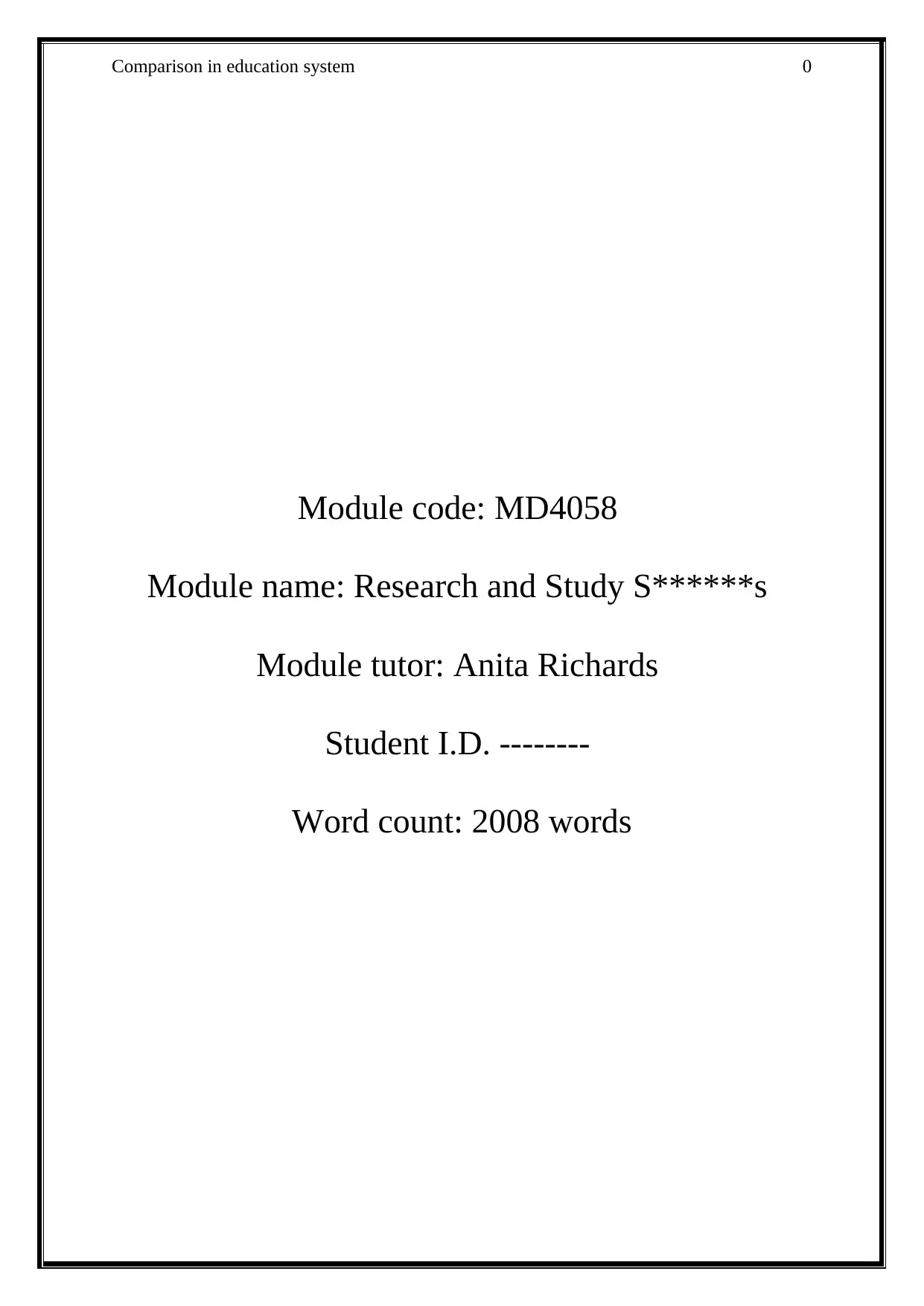
Comparison in education system 0
Module code: MD4058
Module name: Research and Study S******s
Module tutor: Anita Richards
Student I.D. --------
Word count: 2008 words
Module code: MD4058
Module name: Research and Study S******s
Module tutor: Anita Richards
Student I.D. --------
Word count: 2008 words
Paraphrase This Document
Need a fresh take? Get an instant paraphrase of this document with our AI Paraphraser
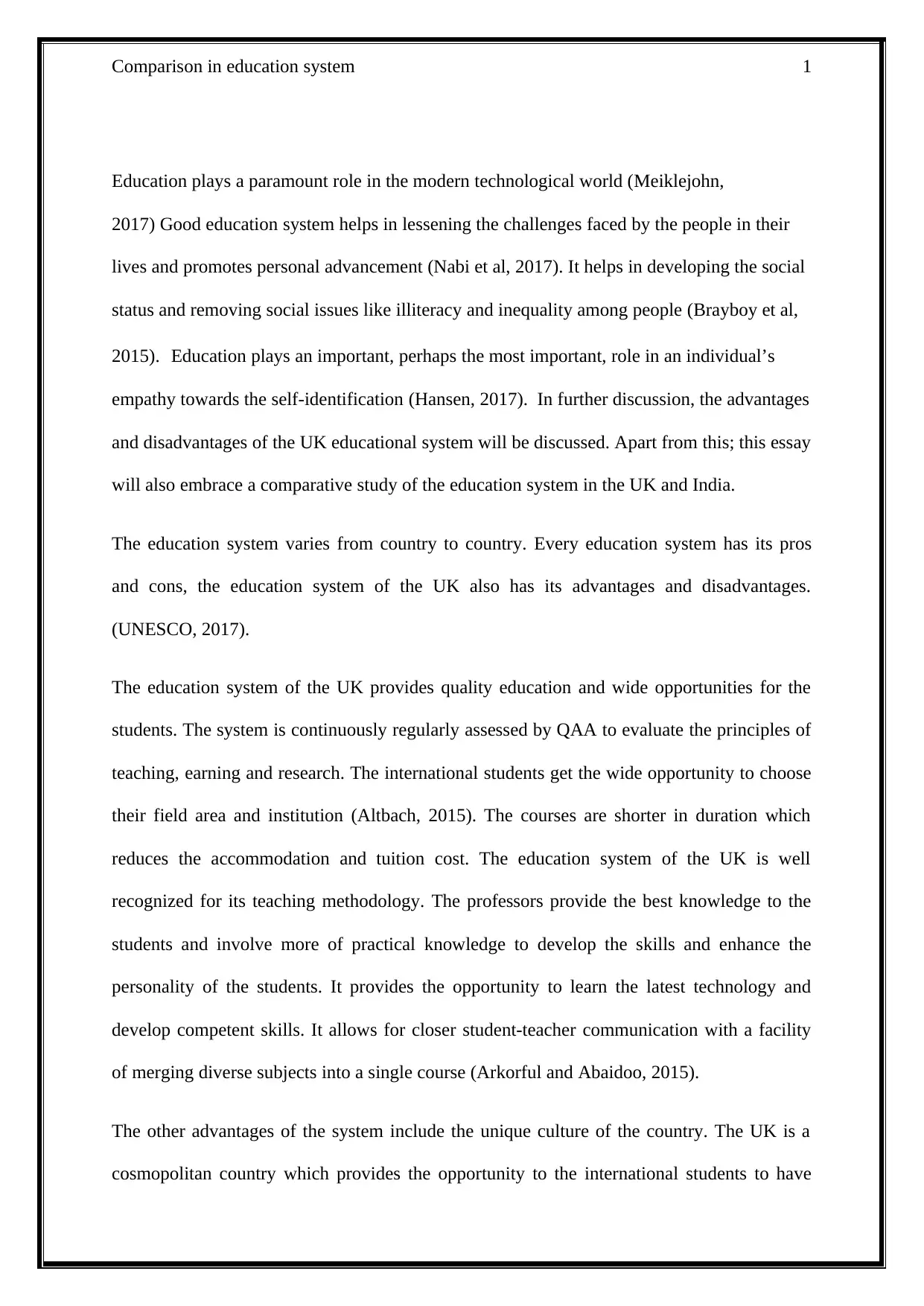
Comparison in education system 1
Education plays a paramount role in the modern technological world (Meiklejohn,
2017) Good education system helps in lessening the challenges faced by the people in their
lives and promotes personal advancement (Nabi et al, 2017). It helps in developing the social
status and removing social issues like illiteracy and inequality among people (Brayboy et al,
2015). Education plays an important, perhaps the most important, role in an individual’s
empathy towards the self-identification (Hansen, 2017). In further discussion, the advantages
and disadvantages of the UK educational system will be discussed. Apart from this; this essay
will also embrace a comparative study of the education system in the UK and India.
The education system varies from country to country. Every education system has its pros
and cons, the education system of the UK also has its advantages and disadvantages.
(UNESCO, 2017).
The education system of the UK provides quality education and wide opportunities for the
students. The system is continuously regularly assessed by QAA to evaluate the principles of
teaching, earning and research. The international students get the wide opportunity to choose
their field area and institution (Altbach, 2015). The courses are shorter in duration which
reduces the accommodation and tuition cost. The education system of the UK is well
recognized for its teaching methodology. The professors provide the best knowledge to the
students and involve more of practical knowledge to develop the skills and enhance the
personality of the students. It provides the opportunity to learn the latest technology and
develop competent skills. It allows for closer student-teacher communication with a facility
of merging diverse subjects into a single course (Arkorful and Abaidoo, 2015).
The other advantages of the system include the unique culture of the country. The UK is a
cosmopolitan country which provides the opportunity to the international students to have
Education plays a paramount role in the modern technological world (Meiklejohn,
2017) Good education system helps in lessening the challenges faced by the people in their
lives and promotes personal advancement (Nabi et al, 2017). It helps in developing the social
status and removing social issues like illiteracy and inequality among people (Brayboy et al,
2015). Education plays an important, perhaps the most important, role in an individual’s
empathy towards the self-identification (Hansen, 2017). In further discussion, the advantages
and disadvantages of the UK educational system will be discussed. Apart from this; this essay
will also embrace a comparative study of the education system in the UK and India.
The education system varies from country to country. Every education system has its pros
and cons, the education system of the UK also has its advantages and disadvantages.
(UNESCO, 2017).
The education system of the UK provides quality education and wide opportunities for the
students. The system is continuously regularly assessed by QAA to evaluate the principles of
teaching, earning and research. The international students get the wide opportunity to choose
their field area and institution (Altbach, 2015). The courses are shorter in duration which
reduces the accommodation and tuition cost. The education system of the UK is well
recognized for its teaching methodology. The professors provide the best knowledge to the
students and involve more of practical knowledge to develop the skills and enhance the
personality of the students. It provides the opportunity to learn the latest technology and
develop competent skills. It allows for closer student-teacher communication with a facility
of merging diverse subjects into a single course (Arkorful and Abaidoo, 2015).
The other advantages of the system include the unique culture of the country. The UK is a
cosmopolitan country which provides the opportunity to the international students to have
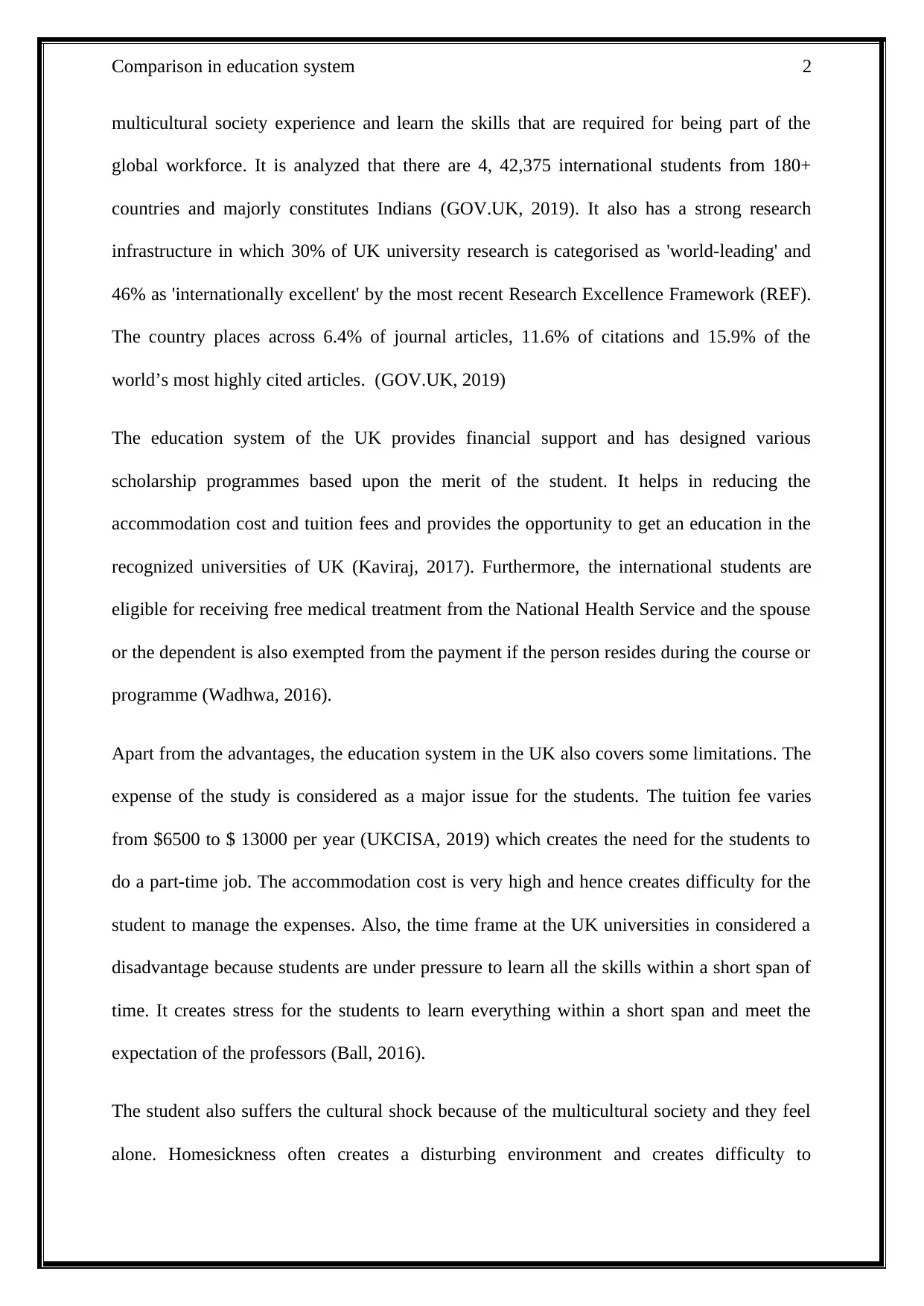
Comparison in education system 2
multicultural society experience and learn the skills that are required for being part of the
global workforce. It is analyzed that there are 4, 42,375 international students from 180+
countries and majorly constitutes Indians (GOV.UK, 2019). It also has a strong research
infrastructure in which 30% of UK university research is categorised as 'world-leading' and
46% as 'internationally excellent' by the most recent Research Excellence Framework (REF).
The country places across 6.4% of journal articles, 11.6% of citations and 15.9% of the
world’s most highly cited articles. (GOV.UK, 2019)
The education system of the UK provides financial support and has designed various
scholarship programmes based upon the merit of the student. It helps in reducing the
accommodation cost and tuition fees and provides the opportunity to get an education in the
recognized universities of UK (Kaviraj, 2017). Furthermore, the international students are
eligible for receiving free medical treatment from the National Health Service and the spouse
or the dependent is also exempted from the payment if the person resides during the course or
programme (Wadhwa, 2016).
Apart from the advantages, the education system in the UK also covers some limitations. The
expense of the study is considered as a major issue for the students. The tuition fee varies
from $6500 to $ 13000 per year (UKCISA, 2019) which creates the need for the students to
do a part-time job. The accommodation cost is very high and hence creates difficulty for the
student to manage the expenses. Also, the time frame at the UK universities in considered a
disadvantage because students are under pressure to learn all the skills within a short span of
time. It creates stress for the students to learn everything within a short span and meet the
expectation of the professors (Ball, 2016).
The student also suffers the cultural shock because of the multicultural society and they feel
alone. Homesickness often creates a disturbing environment and creates difficulty to
multicultural society experience and learn the skills that are required for being part of the
global workforce. It is analyzed that there are 4, 42,375 international students from 180+
countries and majorly constitutes Indians (GOV.UK, 2019). It also has a strong research
infrastructure in which 30% of UK university research is categorised as 'world-leading' and
46% as 'internationally excellent' by the most recent Research Excellence Framework (REF).
The country places across 6.4% of journal articles, 11.6% of citations and 15.9% of the
world’s most highly cited articles. (GOV.UK, 2019)
The education system of the UK provides financial support and has designed various
scholarship programmes based upon the merit of the student. It helps in reducing the
accommodation cost and tuition fees and provides the opportunity to get an education in the
recognized universities of UK (Kaviraj, 2017). Furthermore, the international students are
eligible for receiving free medical treatment from the National Health Service and the spouse
or the dependent is also exempted from the payment if the person resides during the course or
programme (Wadhwa, 2016).
Apart from the advantages, the education system in the UK also covers some limitations. The
expense of the study is considered as a major issue for the students. The tuition fee varies
from $6500 to $ 13000 per year (UKCISA, 2019) which creates the need for the students to
do a part-time job. The accommodation cost is very high and hence creates difficulty for the
student to manage the expenses. Also, the time frame at the UK universities in considered a
disadvantage because students are under pressure to learn all the skills within a short span of
time. It creates stress for the students to learn everything within a short span and meet the
expectation of the professors (Ball, 2016).
The student also suffers the cultural shock because of the multicultural society and they feel
alone. Homesickness often creates a disturbing environment and creates difficulty to
⊘ This is a preview!⊘
Do you want full access?
Subscribe today to unlock all pages.

Trusted by 1+ million students worldwide
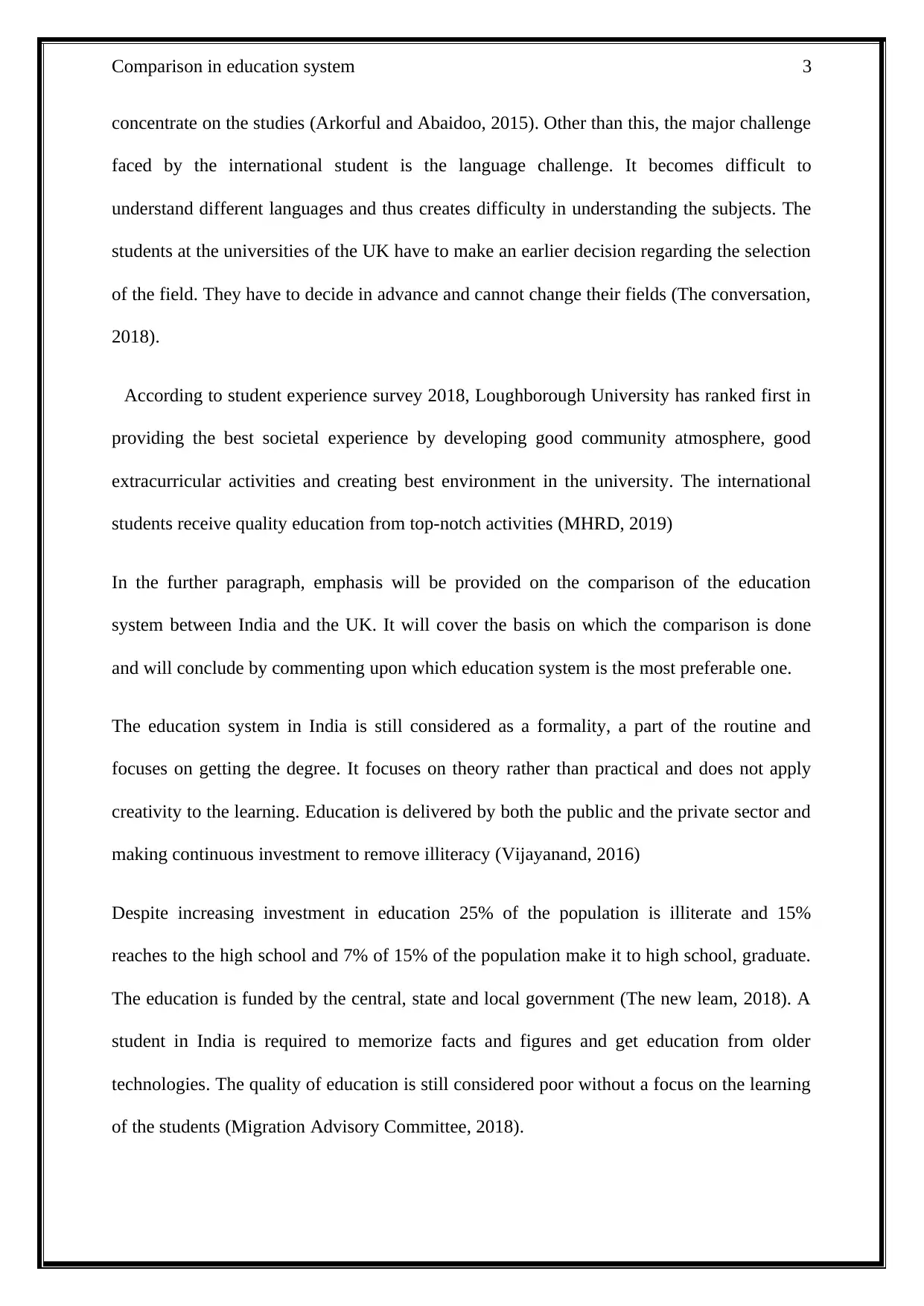
Comparison in education system 3
concentrate on the studies (Arkorful and Abaidoo, 2015). Other than this, the major challenge
faced by the international student is the language challenge. It becomes difficult to
understand different languages and thus creates difficulty in understanding the subjects. The
students at the universities of the UK have to make an earlier decision regarding the selection
of the field. They have to decide in advance and cannot change their fields (The conversation,
2018).
According to student experience survey 2018, Loughborough University has ranked first in
providing the best societal experience by developing good community atmosphere, good
extracurricular activities and creating best environment in the university. The international
students receive quality education from top-notch activities (MHRD, 2019)
In the further paragraph, emphasis will be provided on the comparison of the education
system between India and the UK. It will cover the basis on which the comparison is done
and will conclude by commenting upon which education system is the most preferable one.
The education system in India is still considered as a formality, a part of the routine and
focuses on getting the degree. It focuses on theory rather than practical and does not apply
creativity to the learning. Education is delivered by both the public and the private sector and
making continuous investment to remove illiteracy (Vijayanand, 2016)
Despite increasing investment in education 25% of the population is illiterate and 15%
reaches to the high school and 7% of 15% of the population make it to high school, graduate.
The education is funded by the central, state and local government (The new leam, 2018). A
student in India is required to memorize facts and figures and get education from older
technologies. The quality of education is still considered poor without a focus on the learning
of the students (Migration Advisory Committee, 2018).
concentrate on the studies (Arkorful and Abaidoo, 2015). Other than this, the major challenge
faced by the international student is the language challenge. It becomes difficult to
understand different languages and thus creates difficulty in understanding the subjects. The
students at the universities of the UK have to make an earlier decision regarding the selection
of the field. They have to decide in advance and cannot change their fields (The conversation,
2018).
According to student experience survey 2018, Loughborough University has ranked first in
providing the best societal experience by developing good community atmosphere, good
extracurricular activities and creating best environment in the university. The international
students receive quality education from top-notch activities (MHRD, 2019)
In the further paragraph, emphasis will be provided on the comparison of the education
system between India and the UK. It will cover the basis on which the comparison is done
and will conclude by commenting upon which education system is the most preferable one.
The education system in India is still considered as a formality, a part of the routine and
focuses on getting the degree. It focuses on theory rather than practical and does not apply
creativity to the learning. Education is delivered by both the public and the private sector and
making continuous investment to remove illiteracy (Vijayanand, 2016)
Despite increasing investment in education 25% of the population is illiterate and 15%
reaches to the high school and 7% of 15% of the population make it to high school, graduate.
The education is funded by the central, state and local government (The new leam, 2018). A
student in India is required to memorize facts and figures and get education from older
technologies. The quality of education is still considered poor without a focus on the learning
of the students (Migration Advisory Committee, 2018).
Paraphrase This Document
Need a fresh take? Get an instant paraphrase of this document with our AI Paraphraser
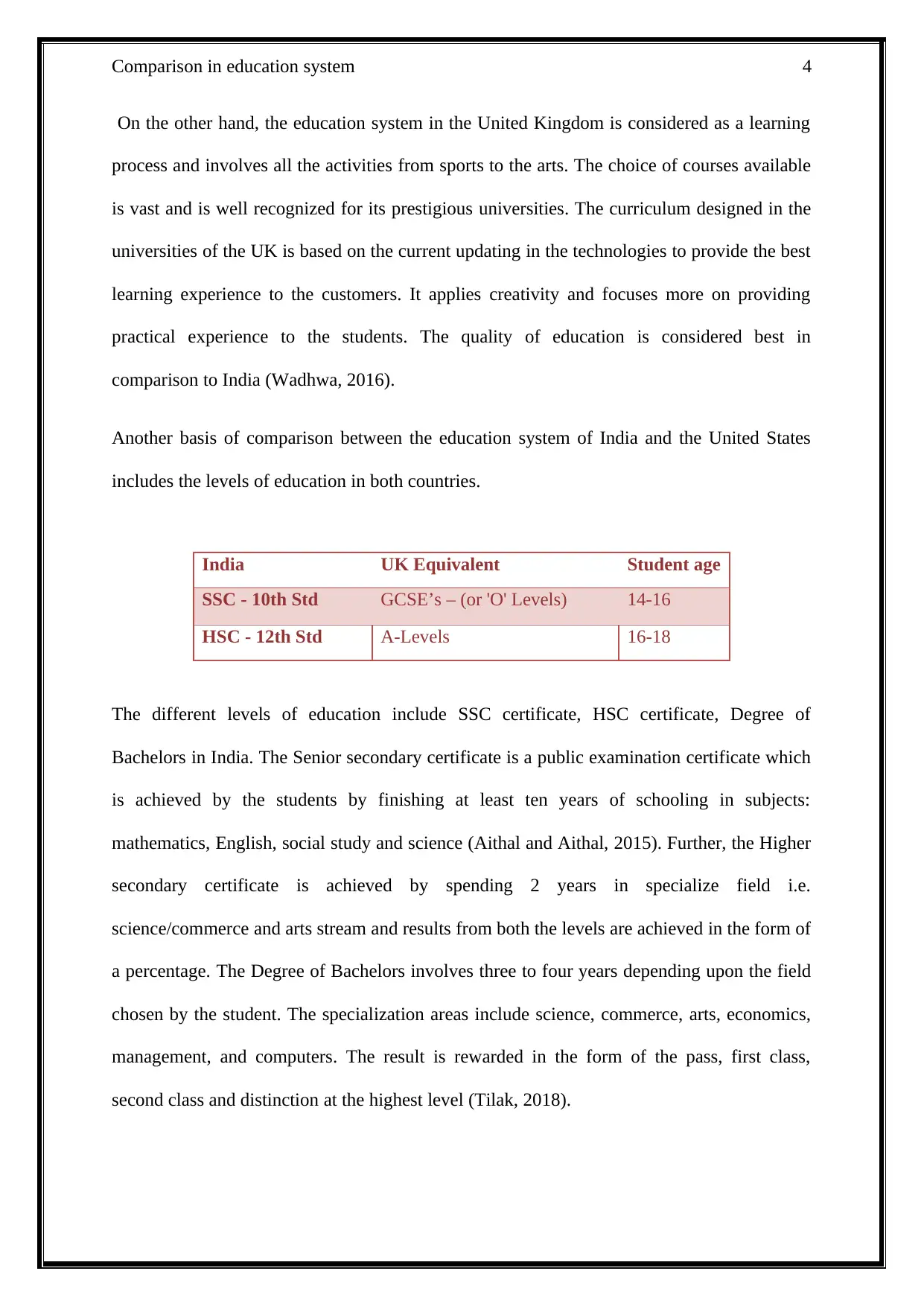
Comparison in education system 4
On the other hand, the education system in the United Kingdom is considered as a learning
process and involves all the activities from sports to the arts. The choice of courses available
is vast and is well recognized for its prestigious universities. The curriculum designed in the
universities of the UK is based on the current updating in the technologies to provide the best
learning experience to the customers. It applies creativity and focuses more on providing
practical experience to the students. The quality of education is considered best in
comparison to India (Wadhwa, 2016).
Another basis of comparison between the education system of India and the United States
includes the levels of education in both countries.
The different levels of education include SSC certificate, HSC certificate, Degree of
Bachelors in India. The Senior secondary certificate is a public examination certificate which
is achieved by the students by finishing at least ten years of schooling in subjects:
mathematics, English, social study and science (Aithal and Aithal, 2015). Further, the Higher
secondary certificate is achieved by spending 2 years in specialize field i.e.
science/commerce and arts stream and results from both the levels are achieved in the form of
a percentage. The Degree of Bachelors involves three to four years depending upon the field
chosen by the student. The specialization areas include science, commerce, arts, economics,
management, and computers. The result is rewarded in the form of the pass, first class,
second class and distinction at the highest level (Tilak, 2018).
India UK Equivalent Student age
SSC - 10th Std GCSE’s – (or 'O' Levels) 14-16
HSC - 12th Std A-Levels 16-18
On the other hand, the education system in the United Kingdom is considered as a learning
process and involves all the activities from sports to the arts. The choice of courses available
is vast and is well recognized for its prestigious universities. The curriculum designed in the
universities of the UK is based on the current updating in the technologies to provide the best
learning experience to the customers. It applies creativity and focuses more on providing
practical experience to the students. The quality of education is considered best in
comparison to India (Wadhwa, 2016).
Another basis of comparison between the education system of India and the United States
includes the levels of education in both countries.
The different levels of education include SSC certificate, HSC certificate, Degree of
Bachelors in India. The Senior secondary certificate is a public examination certificate which
is achieved by the students by finishing at least ten years of schooling in subjects:
mathematics, English, social study and science (Aithal and Aithal, 2015). Further, the Higher
secondary certificate is achieved by spending 2 years in specialize field i.e.
science/commerce and arts stream and results from both the levels are achieved in the form of
a percentage. The Degree of Bachelors involves three to four years depending upon the field
chosen by the student. The specialization areas include science, commerce, arts, economics,
management, and computers. The result is rewarded in the form of the pass, first class,
second class and distinction at the highest level (Tilak, 2018).
India UK Equivalent Student age
SSC - 10th Std GCSE’s – (or 'O' Levels) 14-16
HSC - 12th Std A-Levels 16-18
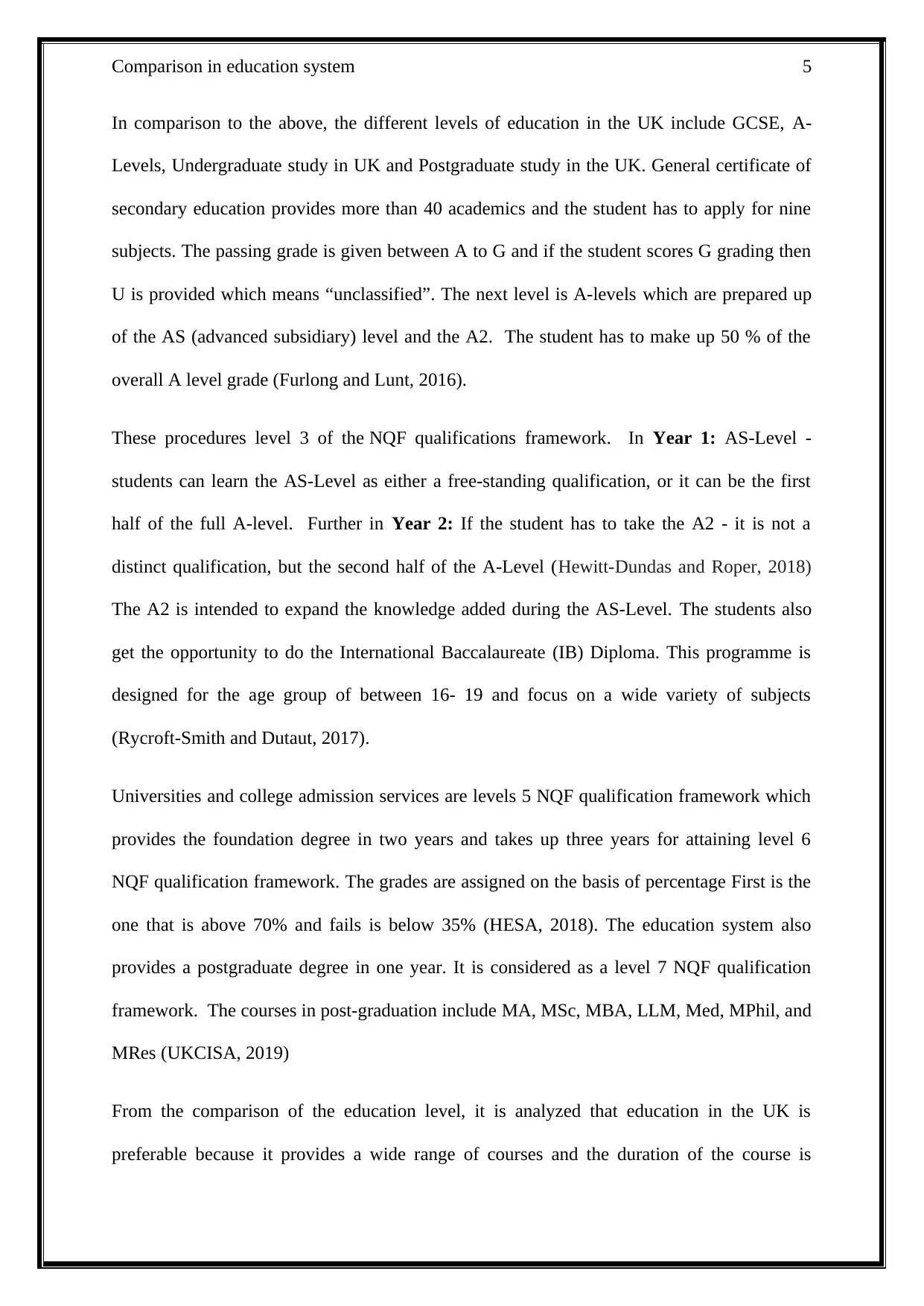
Comparison in education system 5
In comparison to the above, the different levels of education in the UK include GCSE, A-
Levels, Undergraduate study in UK and Postgraduate study in the UK. General certificate of
secondary education provides more than 40 academics and the student has to apply for nine
subjects. The passing grade is given between A to G and if the student scores G grading then
U is provided which means “unclassified”. The next level is A-levels which are prepared up
of the AS (advanced subsidiary) level and the A2. The student has to make up 50 % of the
overall A level grade (Furlong and Lunt, 2016).
These procedures level 3 of the NQF qualifications framework. In Year 1: AS-Level -
students can learn the AS-Level as either a free-standing qualification, or it can be the first
half of the full A-level. Further in Year 2: If the student has to take the A2 - it is not a
distinct qualification, but the second half of the A-Level (Hewitt-Dundas and Roper, 2018)
The A2 is intended to expand the knowledge added during the AS-Level. The students also
get the opportunity to do the International Baccalaureate (IB) Diploma. This programme is
designed for the age group of between 16- 19 and focus on a wide variety of subjects
(Rycroft-Smith and Dutaut, 2017).
Universities and college admission services are levels 5 NQF qualification framework which
provides the foundation degree in two years and takes up three years for attaining level 6
NQF qualification framework. The grades are assigned on the basis of percentage First is the
one that is above 70% and fails is below 35% (HESA, 2018). The education system also
provides a postgraduate degree in one year. It is considered as a level 7 NQF qualification
framework. The courses in post-graduation include MA, MSc, MBA, LLM, Med, MPhil, and
MRes (UKCISA, 2019)
From the comparison of the education level, it is analyzed that education in the UK is
preferable because it provides a wide range of courses and the duration of the course is
In comparison to the above, the different levels of education in the UK include GCSE, A-
Levels, Undergraduate study in UK and Postgraduate study in the UK. General certificate of
secondary education provides more than 40 academics and the student has to apply for nine
subjects. The passing grade is given between A to G and if the student scores G grading then
U is provided which means “unclassified”. The next level is A-levels which are prepared up
of the AS (advanced subsidiary) level and the A2. The student has to make up 50 % of the
overall A level grade (Furlong and Lunt, 2016).
These procedures level 3 of the NQF qualifications framework. In Year 1: AS-Level -
students can learn the AS-Level as either a free-standing qualification, or it can be the first
half of the full A-level. Further in Year 2: If the student has to take the A2 - it is not a
distinct qualification, but the second half of the A-Level (Hewitt-Dundas and Roper, 2018)
The A2 is intended to expand the knowledge added during the AS-Level. The students also
get the opportunity to do the International Baccalaureate (IB) Diploma. This programme is
designed for the age group of between 16- 19 and focus on a wide variety of subjects
(Rycroft-Smith and Dutaut, 2017).
Universities and college admission services are levels 5 NQF qualification framework which
provides the foundation degree in two years and takes up three years for attaining level 6
NQF qualification framework. The grades are assigned on the basis of percentage First is the
one that is above 70% and fails is below 35% (HESA, 2018). The education system also
provides a postgraduate degree in one year. It is considered as a level 7 NQF qualification
framework. The courses in post-graduation include MA, MSc, MBA, LLM, Med, MPhil, and
MRes (UKCISA, 2019)
From the comparison of the education level, it is analyzed that education in the UK is
preferable because it provides a wide range of courses and the duration of the course is
⊘ This is a preview!⊘
Do you want full access?
Subscribe today to unlock all pages.

Trusted by 1+ million students worldwide

Comparison in education system 6
comparatively less in the UK as compared to India (Rycroft-Smith and Dutaut, 2017) The
education system of UK focuses on creativity and developing an effective learning process to
develop the personality of the students and provide wide enhancement opportunities. The job
and the pay scale are high when the student studies from the UK (Ball, 2016).
It is analyzed that the main reasons for the lower level of literacy in India are the imbalances
of gender and income. The households do not have the income to get an education and the
government school is not equipped with qualified teachers. There is a lack of proper
sanitation facilities which becomes the reason for maximum dropouts among children. To
improve the literacy level Government of India has developed a scheme of Infrastructure
Development in Minority Institutes to provide aid of up to 75 % and provides Rs. 50 lakhs
per institution to strengthen the education infrastructure and other physical facilities.(MHRD,
2019). The government of India has incorporated “right of children to free and compulsory
education” act 2009 which signifies the significant legislation foreseen under Article 21-A to
provide the right to free and compulsory education to those who are not supported by their
parents (MHRD, 2019).
From the above analysis, it is recommended that the government of India must add top-notch
technologies to deliver quality education to the students and must focus more on the
learning’s of the student. The curriculum for the students must be updated according to the
changes in the environment and must focus on enhancing the personality of the students by
delivering more practical knowledge (Aladag and Dal, 2018).
The accommodation and the tuition cost on the UK universities must be reduced so that the
issue of expense does not become a concern for the students and the international student can
afford the cost of the study. Further, it is analyzed that the time frame for different levels of
education in India is higher as compared to the education level of the United Kingdom.
comparatively less in the UK as compared to India (Rycroft-Smith and Dutaut, 2017) The
education system of UK focuses on creativity and developing an effective learning process to
develop the personality of the students and provide wide enhancement opportunities. The job
and the pay scale are high when the student studies from the UK (Ball, 2016).
It is analyzed that the main reasons for the lower level of literacy in India are the imbalances
of gender and income. The households do not have the income to get an education and the
government school is not equipped with qualified teachers. There is a lack of proper
sanitation facilities which becomes the reason for maximum dropouts among children. To
improve the literacy level Government of India has developed a scheme of Infrastructure
Development in Minority Institutes to provide aid of up to 75 % and provides Rs. 50 lakhs
per institution to strengthen the education infrastructure and other physical facilities.(MHRD,
2019). The government of India has incorporated “right of children to free and compulsory
education” act 2009 which signifies the significant legislation foreseen under Article 21-A to
provide the right to free and compulsory education to those who are not supported by their
parents (MHRD, 2019).
From the above analysis, it is recommended that the government of India must add top-notch
technologies to deliver quality education to the students and must focus more on the
learning’s of the student. The curriculum for the students must be updated according to the
changes in the environment and must focus on enhancing the personality of the students by
delivering more practical knowledge (Aladag and Dal, 2018).
The accommodation and the tuition cost on the UK universities must be reduced so that the
issue of expense does not become a concern for the students and the international student can
afford the cost of the study. Further, it is analyzed that the time frame for different levels of
education in India is higher as compared to the education level of the United Kingdom.
Paraphrase This Document
Need a fresh take? Get an instant paraphrase of this document with our AI Paraphraser

Comparison in education system 7
However, India should reduce the time frame to provide the opportunity to equip higher
qualifications and must provide a wide variety of courses to the students to get the
opportunity of higher positions and pay scale (Sheikh, 2017).
From the above discussion, it is concluded that education has become crucial to develop a
positive identity in the global world. It plays a major role in upgrading the standard of living
and helps in removing the social issues. It is scrutinized that the education system of the
United Kingdom is preferable in comparison to the Indian education system because of the
universities of UK provides quality education with the latest technology. It considers it a
learning process while the education system of India is a routine process with traditional
teaching methods and more focus on theoretical aspects.
However, India should reduce the time frame to provide the opportunity to equip higher
qualifications and must provide a wide variety of courses to the students to get the
opportunity of higher positions and pay scale (Sheikh, 2017).
From the above discussion, it is concluded that education has become crucial to develop a
positive identity in the global world. It plays a major role in upgrading the standard of living
and helps in removing the social issues. It is scrutinized that the education system of the
United Kingdom is preferable in comparison to the Indian education system because of the
universities of UK provides quality education with the latest technology. It considers it a
learning process while the education system of India is a routine process with traditional
teaching methods and more focus on theoretical aspects.
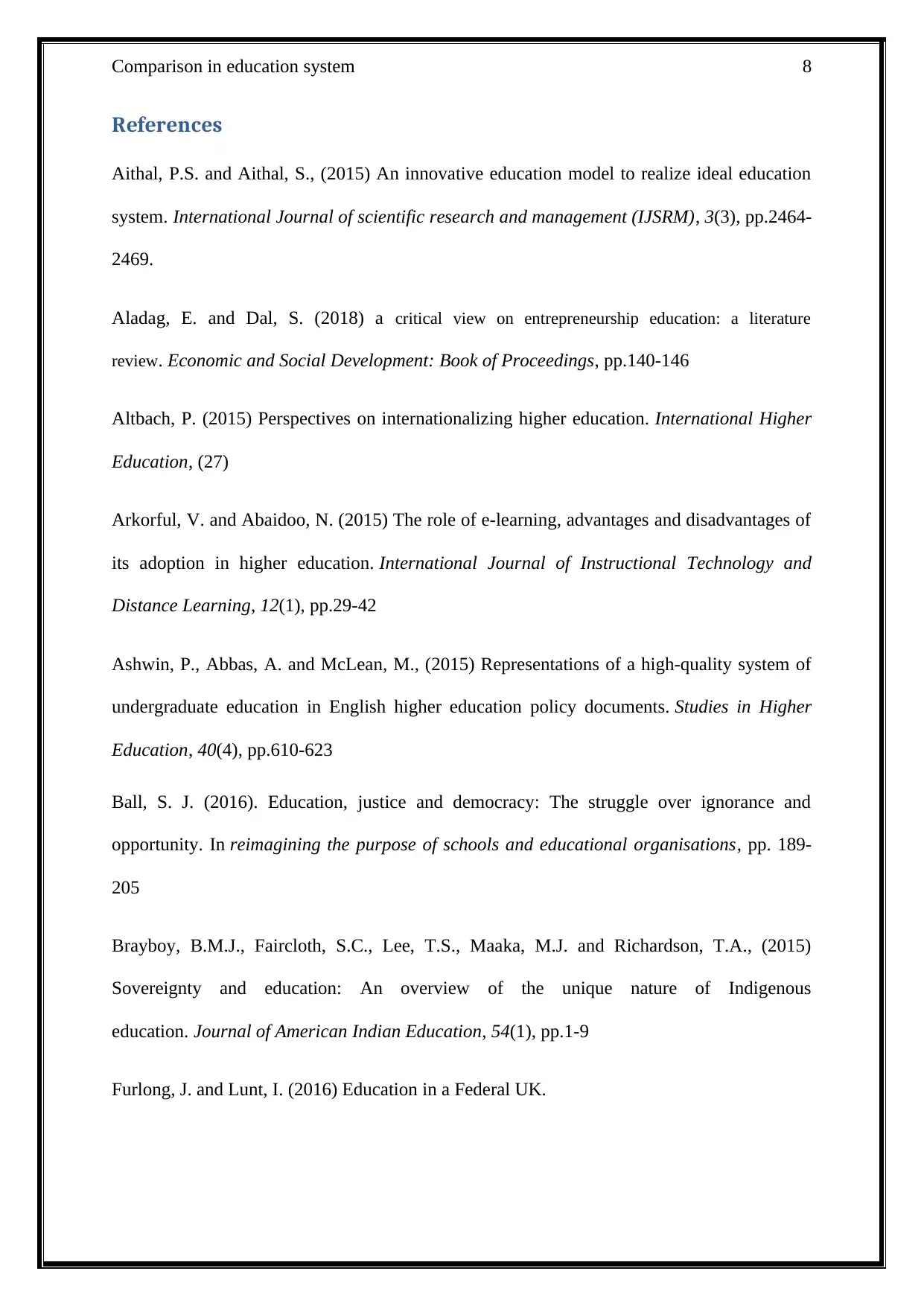
Comparison in education system 8
References
Aithal, P.S. and Aithal, S., (2015) An innovative education model to realize ideal education
system. International Journal of scientific research and management (IJSRM), 3(3), pp.2464-
2469.
Aladag, E. and Dal, S. (2018) a critical view on entrepreneurship education: a literature
review. Economic and Social Development: Book of Proceedings, pp.140-146
Altbach, P. (2015) Perspectives on internationalizing higher education. International Higher
Education, (27)
Arkorful, V. and Abaidoo, N. (2015) The role of e-learning, advantages and disadvantages of
its adoption in higher education. International Journal of Instructional Technology and
Distance Learning, 12(1), pp.29-42
Ashwin, P., Abbas, A. and McLean, M., (2015) Representations of a high-quality system of
undergraduate education in English higher education policy documents. Studies in Higher
Education, 40(4), pp.610-623
Ball, S. J. (2016). Education, justice and democracy: The struggle over ignorance and
opportunity. In reimagining the purpose of schools and educational organisations, pp. 189-
205
Brayboy, B.M.J., Faircloth, S.C., Lee, T.S., Maaka, M.J. and Richardson, T.A., (2015)
Sovereignty and education: An overview of the unique nature of Indigenous
education. Journal of American Indian Education, 54(1), pp.1-9
Furlong, J. and Lunt, I. (2016) Education in a Federal UK.
References
Aithal, P.S. and Aithal, S., (2015) An innovative education model to realize ideal education
system. International Journal of scientific research and management (IJSRM), 3(3), pp.2464-
2469.
Aladag, E. and Dal, S. (2018) a critical view on entrepreneurship education: a literature
review. Economic and Social Development: Book of Proceedings, pp.140-146
Altbach, P. (2015) Perspectives on internationalizing higher education. International Higher
Education, (27)
Arkorful, V. and Abaidoo, N. (2015) The role of e-learning, advantages and disadvantages of
its adoption in higher education. International Journal of Instructional Technology and
Distance Learning, 12(1), pp.29-42
Ashwin, P., Abbas, A. and McLean, M., (2015) Representations of a high-quality system of
undergraduate education in English higher education policy documents. Studies in Higher
Education, 40(4), pp.610-623
Ball, S. J. (2016). Education, justice and democracy: The struggle over ignorance and
opportunity. In reimagining the purpose of schools and educational organisations, pp. 189-
205
Brayboy, B.M.J., Faircloth, S.C., Lee, T.S., Maaka, M.J. and Richardson, T.A., (2015)
Sovereignty and education: An overview of the unique nature of Indigenous
education. Journal of American Indian Education, 54(1), pp.1-9
Furlong, J. and Lunt, I. (2016) Education in a Federal UK.
⊘ This is a preview!⊘
Do you want full access?
Subscribe today to unlock all pages.

Trusted by 1+ million students worldwide
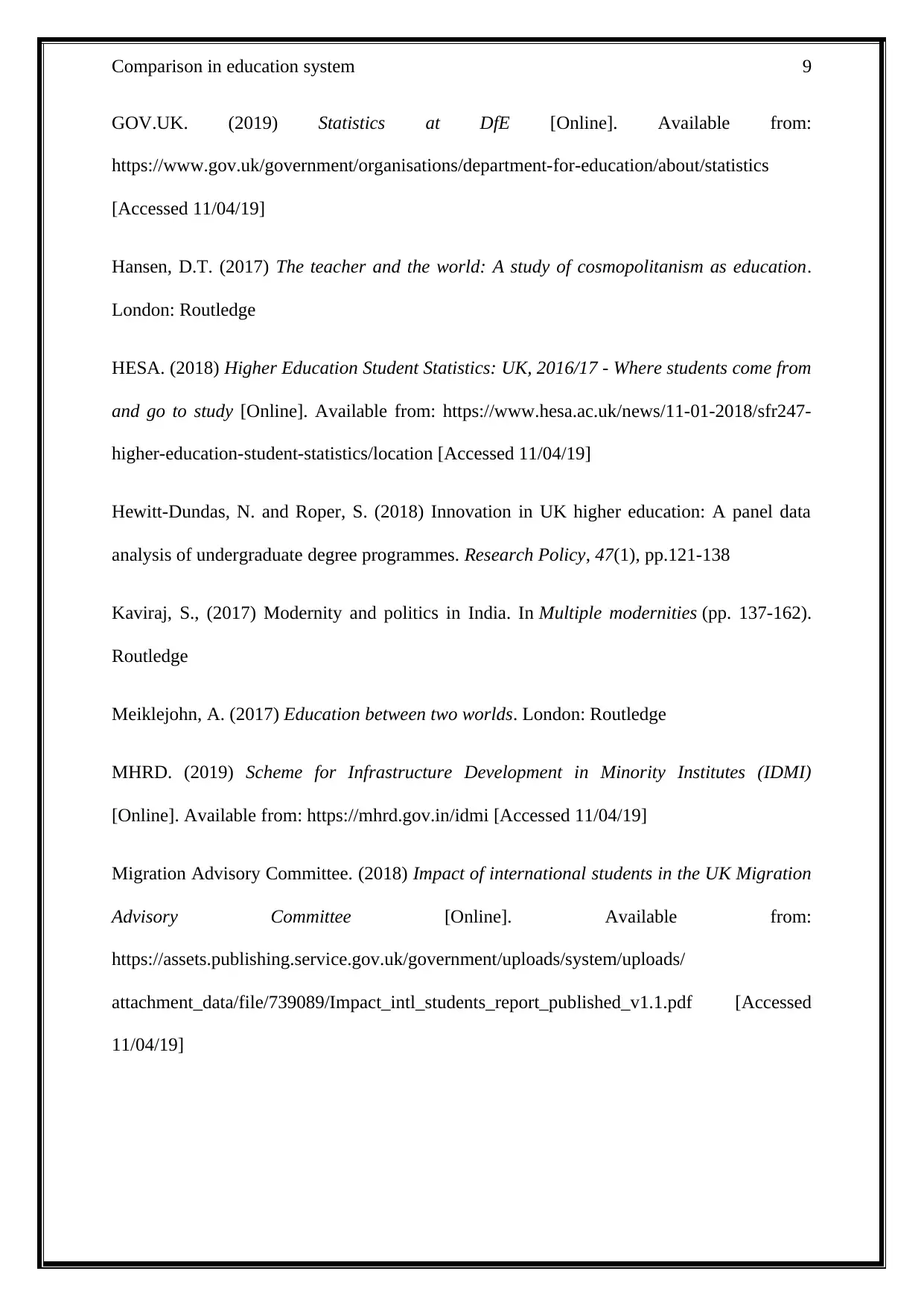
Comparison in education system 9
GOV.UK. (2019) Statistics at DfE [Online]. Available from:
https://www.gov.uk/government/organisations/department-for-education/about/statistics
[Accessed 11/04/19]
Hansen, D.T. (2017) The teacher and the world: A study of cosmopolitanism as education.
London: Routledge
HESA. (2018) Higher Education Student Statistics: UK, 2016/17 - Where students come from
and go to study [Online]. Available from: https://www.hesa.ac.uk/news/11-01-2018/sfr247-
higher-education-student-statistics/location [Accessed 11/04/19]
Hewitt-Dundas, N. and Roper, S. (2018) Innovation in UK higher education: A panel data
analysis of undergraduate degree programmes. Research Policy, 47(1), pp.121-138
Kaviraj, S., (2017) Modernity and politics in India. In Multiple modernities (pp. 137-162).
Routledge
Meiklejohn, A. (2017) Education between two worlds. London: Routledge
MHRD. (2019) Scheme for Infrastructure Development in Minority Institutes (IDMI)
[Online]. Available from: https://mhrd.gov.in/idmi [Accessed 11/04/19]
Migration Advisory Committee. (2018) Impact of international students in the UK Migration
Advisory Committee [Online]. Available from:
https://assets.publishing.service.gov.uk/government/uploads/system/uploads/
attachment_data/file/739089/Impact_intl_students_report_published_v1.1.pdf [Accessed
11/04/19]
GOV.UK. (2019) Statistics at DfE [Online]. Available from:
https://www.gov.uk/government/organisations/department-for-education/about/statistics
[Accessed 11/04/19]
Hansen, D.T. (2017) The teacher and the world: A study of cosmopolitanism as education.
London: Routledge
HESA. (2018) Higher Education Student Statistics: UK, 2016/17 - Where students come from
and go to study [Online]. Available from: https://www.hesa.ac.uk/news/11-01-2018/sfr247-
higher-education-student-statistics/location [Accessed 11/04/19]
Hewitt-Dundas, N. and Roper, S. (2018) Innovation in UK higher education: A panel data
analysis of undergraduate degree programmes. Research Policy, 47(1), pp.121-138
Kaviraj, S., (2017) Modernity and politics in India. In Multiple modernities (pp. 137-162).
Routledge
Meiklejohn, A. (2017) Education between two worlds. London: Routledge
MHRD. (2019) Scheme for Infrastructure Development in Minority Institutes (IDMI)
[Online]. Available from: https://mhrd.gov.in/idmi [Accessed 11/04/19]
Migration Advisory Committee. (2018) Impact of international students in the UK Migration
Advisory Committee [Online]. Available from:
https://assets.publishing.service.gov.uk/government/uploads/system/uploads/
attachment_data/file/739089/Impact_intl_students_report_published_v1.1.pdf [Accessed
11/04/19]
Paraphrase This Document
Need a fresh take? Get an instant paraphrase of this document with our AI Paraphraser
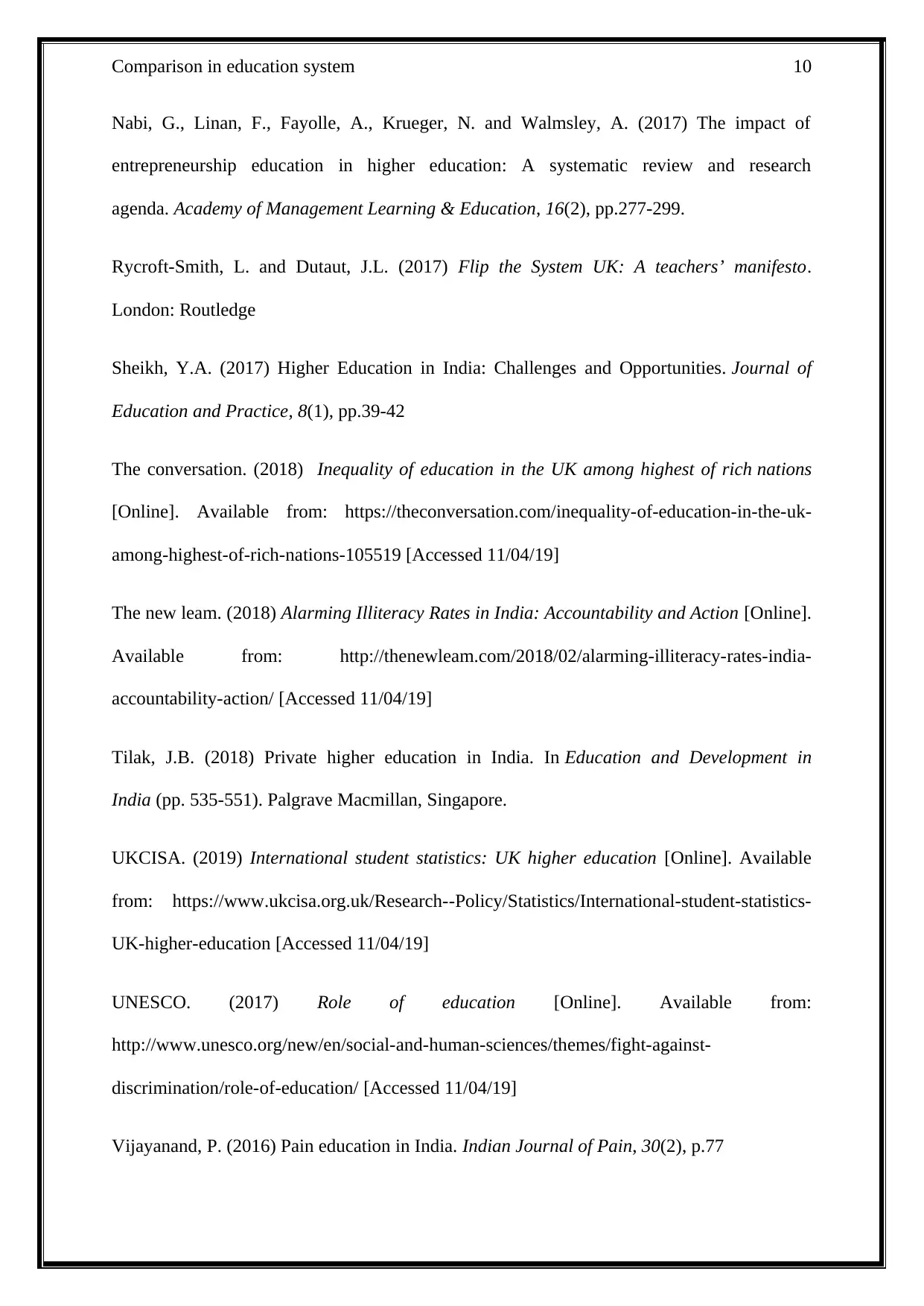
Comparison in education system 10
Nabi, G., Linan, F., Fayolle, A., Krueger, N. and Walmsley, A. (2017) The impact of
entrepreneurship education in higher education: A systematic review and research
agenda. Academy of Management Learning & Education, 16(2), pp.277-299.
Rycroft-Smith, L. and Dutaut, J.L. (2017) Flip the System UK: A teachers’ manifesto.
London: Routledge
Sheikh, Y.A. (2017) Higher Education in India: Challenges and Opportunities. Journal of
Education and Practice, 8(1), pp.39-42
The conversation. (2018) Inequality of education in the UK among highest of rich nations
[Online]. Available from: https://theconversation.com/inequality-of-education-in-the-uk-
among-highest-of-rich-nations-105519 [Accessed 11/04/19]
The new leam. (2018) Alarming Illiteracy Rates in India: Accountability and Action [Online].
Available from: http://thenewleam.com/2018/02/alarming-illiteracy-rates-india-
accountability-action/ [Accessed 11/04/19]
Tilak, J.B. (2018) Private higher education in India. In Education and Development in
India (pp. 535-551). Palgrave Macmillan, Singapore.
UKCISA. (2019) International student statistics: UK higher education [Online]. Available
from: https://www.ukcisa.org.uk/Research--Policy/Statistics/International-student-statistics-
UK-higher-education [Accessed 11/04/19]
UNESCO. (2017) Role of education [Online]. Available from:
http://www.unesco.org/new/en/social-and-human-sciences/themes/fight-against-
discrimination/role-of-education/ [Accessed 11/04/19]
Vijayanand, P. (2016) Pain education in India. Indian Journal of Pain, 30(2), p.77
Nabi, G., Linan, F., Fayolle, A., Krueger, N. and Walmsley, A. (2017) The impact of
entrepreneurship education in higher education: A systematic review and research
agenda. Academy of Management Learning & Education, 16(2), pp.277-299.
Rycroft-Smith, L. and Dutaut, J.L. (2017) Flip the System UK: A teachers’ manifesto.
London: Routledge
Sheikh, Y.A. (2017) Higher Education in India: Challenges and Opportunities. Journal of
Education and Practice, 8(1), pp.39-42
The conversation. (2018) Inequality of education in the UK among highest of rich nations
[Online]. Available from: https://theconversation.com/inequality-of-education-in-the-uk-
among-highest-of-rich-nations-105519 [Accessed 11/04/19]
The new leam. (2018) Alarming Illiteracy Rates in India: Accountability and Action [Online].
Available from: http://thenewleam.com/2018/02/alarming-illiteracy-rates-india-
accountability-action/ [Accessed 11/04/19]
Tilak, J.B. (2018) Private higher education in India. In Education and Development in
India (pp. 535-551). Palgrave Macmillan, Singapore.
UKCISA. (2019) International student statistics: UK higher education [Online]. Available
from: https://www.ukcisa.org.uk/Research--Policy/Statistics/International-student-statistics-
UK-higher-education [Accessed 11/04/19]
UNESCO. (2017) Role of education [Online]. Available from:
http://www.unesco.org/new/en/social-and-human-sciences/themes/fight-against-
discrimination/role-of-education/ [Accessed 11/04/19]
Vijayanand, P. (2016) Pain education in India. Indian Journal of Pain, 30(2), p.77
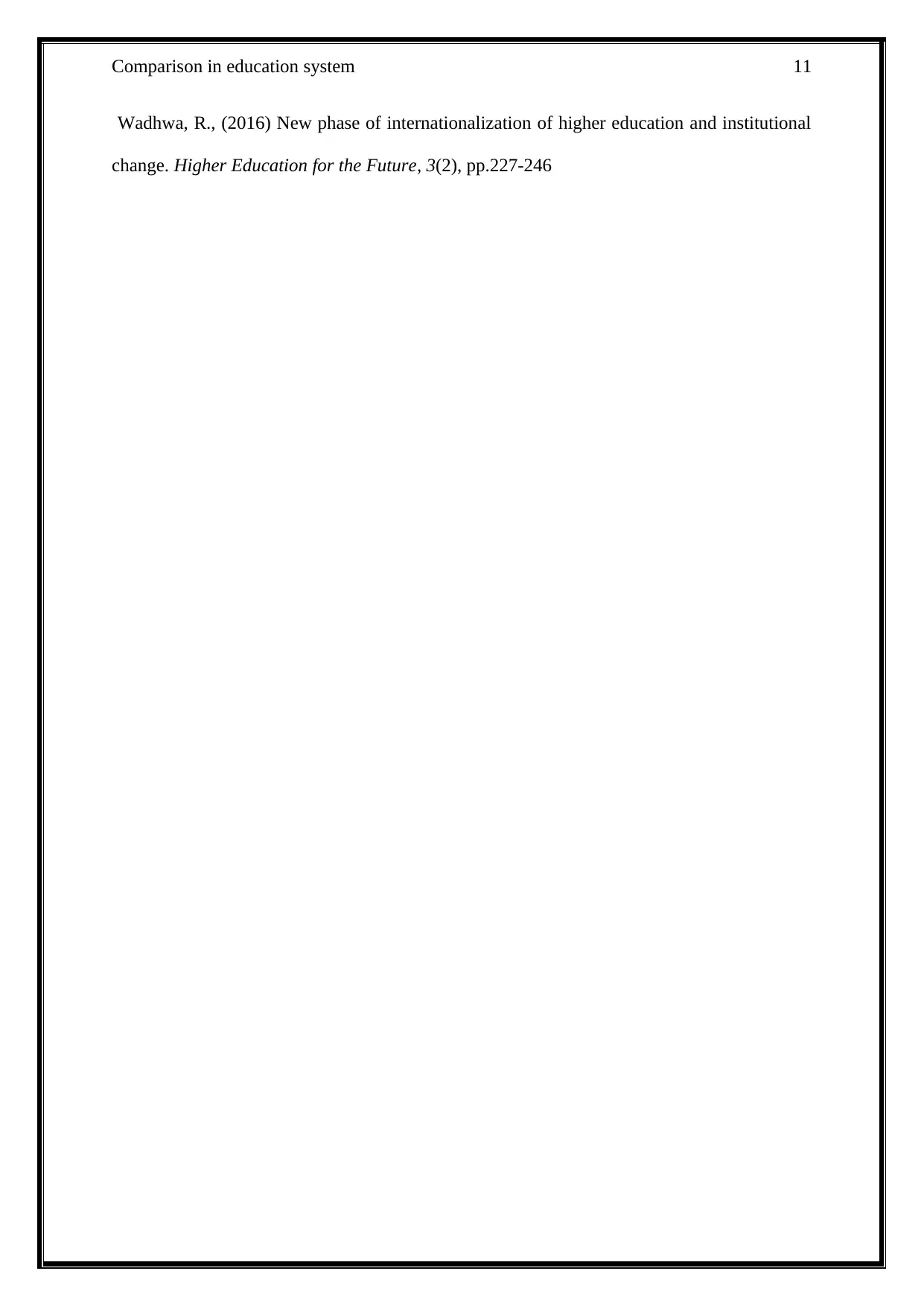
Comparison in education system 11
Wadhwa, R., (2016) New phase of internationalization of higher education and institutional
change. Higher Education for the Future, 3(2), pp.227-246
Wadhwa, R., (2016) New phase of internationalization of higher education and institutional
change. Higher Education for the Future, 3(2), pp.227-246
⊘ This is a preview!⊘
Do you want full access?
Subscribe today to unlock all pages.

Trusted by 1+ million students worldwide
1 out of 12
Related Documents
Your All-in-One AI-Powered Toolkit for Academic Success.
+13062052269
info@desklib.com
Available 24*7 on WhatsApp / Email
![[object Object]](/_next/static/media/star-bottom.7253800d.svg)
Unlock your academic potential
Copyright © 2020–2025 A2Z Services. All Rights Reserved. Developed and managed by ZUCOL.



